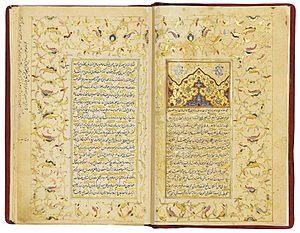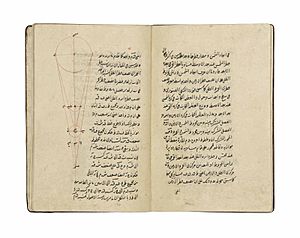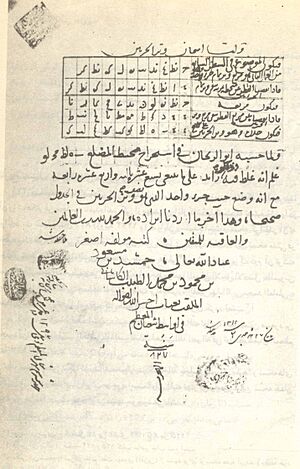Jamshid al-Kashi facts for kids
Quick facts for kids Ghiyāth al-Dīn Jamshīd Kāshānī |
|
|---|---|

Opening bifolio of a manuscript of al-Kashi's Miftah al-Hisab. Copy created in Safavid Iran, dated 1656
|
|
| Religion | Islam |
| Personal | |
| Born | c. 1380 Kashan, Iran |
| Died | 22 June 1429 (aged 48) Samarkand, Transoxania |
| Senior posting | |
| Title | al-Kashi |
| Religious career | |
| Works | Sullam al-Sama |
Ghiyāth al-Dīn Jamshīd Masʿūd al-Kāshī (also known as al-Kāshānī) was a brilliant Persian astronomer and mathematician. He lived during the time of Tamerlane and his family. Al-Kashi was born around 1380 in Kashan, Iran, and passed away on June 22, 1429, in Samarkand, Transoxania.
Many of al-Kashi's amazing discoveries were not known in Europe for a long time. Some of his writings are still not fully published today.
Contents
Biography

Al-Kashi was born in 1380 in Kashan, a city in central Iran. At that time, this area was ruled by a powerful leader named Tamerlane.
Things got better for scholars when Tamerlane died in 1405. His son, Shah Rukh, became the new ruler. Shah Rukh and his wife, Goharshad, loved science and learning. They encouraged people in their court to study many different subjects. Because of this, their time was a period of great achievements in learning. This was the perfect time for al-Kashi to become one of the world's greatest mathematicians.
In 1409, Shah Rukh's son, Ulugh Beg, started an important learning center in Samarkand. This center quickly became a famous university. Students from all over the Middle East came to study there. Ulugh Beg brought together many smart mathematicians and scientists. In 1414, al-Kashi joined them. He made many of his most important discoveries while working with Ulugh Beg.
Al-Kashi was still working on his book, "The Treatise on the Chord and Sine," when he died. This was likely in 1429. Some historians believe that Ulugh Beg might have ordered his death. This could have happened because al-Kashi disagreed with some religious leaders.
Astronomy
Khaqani Zij: Star Tables
Al-Kashi created a special set of astronomical tables called the Khaqani Zij. These tables were based on earlier work by Nasir al-Din al-Tusi. In his Khaqani Zij, al-Kashi thanked the ruler Ulugh Beg. Ulugh Beg had invited al-Kashi to work at his observatory and his university.
Al-Kashi's tables were very precise. They included sine values that were accurate to eight decimal places. He also created tables to help convert between different ways of mapping the sky. This included changing from the ecliptic coordinate system to the equatorial coordinate system.
Astronomical Treatise on Heavenly Bodies
He wrote a book called Sullam al-Sama. This book helped solve problems that earlier scholars had with measuring the sizes and distances of heavenly bodies. These included the Earth, the Moon, the Sun, and the stars.
Treatise on Astronomical Observational Instruments
In 1416, al-Kashi wrote a book about different tools used to observe the sky. This book, called the Treatise on Astronomical Observational Instruments, described many devices. These included the triquetrum and the armillary sphere. He also described the sextant and a special double quadrant Azimuth-altitude instrument that he invented himself. He also created a small armillary sphere with an alhidade.
Plate of Conjunctions
Al-Kashi invented a clever tool called the Plate of Conjunctions. This was like an early computer. It helped astronomers figure out when planets would line up in the sky. It could also perform linear interpolation, which is a way to estimate values between known points.
Planetary Computer
Al-Kashi also created a mechanical computer for planets. He called it the Plate of Zones. This device could solve many problems about planets. It could predict where the Sun and Moon would be in the sky. It could also show the positions of other planets in their elliptical orbits. The instrument also had an alhidade and a ruler.
Mathematics
Law of Cosines
In French, the law of cosines is often called Théorème d'Al-Kashi (Theorem of Al-Kashi). This is because al-Kashi was the first to clearly write down this law. It was presented in a way that was useful for triangulation, which is a method for measuring distances. He also wrote another important work called "The Treatise on the Circumference."
The Treatise of Chord and Sine
In his book The Treatise on the Chord and Sine, al-Kashi calculated the value of sin 1°. His calculation was almost as accurate as his value for π. This was the most accurate value for sin 1° known at that time. No one surpassed it until the 16th century.
In algebra and numerical analysis, al-Kashi developed a special method for solving cubic equations. This method was not discovered in Europe until hundreds of years later. He also improved on a method similar to Newton's method to find roots of numbers.
To find sin 1°, al-Kashi discovered a formula. This formula is often given credit to François Viète in the 16th century: 
The Key to Arithmetic
Calculating Pi
In 1424, al-Kashi made an amazing calculation. He correctly figured out 2π to 9 sexagesimal digits. He then changed this to 16 decimal places of accuracy. This was much more accurate than any previous calculations of π. For example, Ptolemy in ancient Greece only got 3 decimal places. Zu Chongzhi in China got 7 decimal places.
Al-Kashi's incredibly accurate calculation of π was not beaten for 180 years. His goal was to calculate the circle constant so precisely that he could measure the circumference of the largest possible circle (the ecliptic) with extreme accuracy, like the width of a single hair!
Biographical Film
In 2009, a TV series about the life of Jamshid Al-Kāshi was made in Iran. It was called The Ladder of the Sky (Nardebām-e Āsmān). The series had 15 parts, each 45 minutes long. It was directed by Mohammad Hossein Latifi. The adult Jamshid Al-Kāshi was played by Vahid Jalilvand.
See also
 In Spanish: Ghiyath al-Din Jamshid Mas'ud al-Kashi para niños
In Spanish: Ghiyath al-Din Jamshid Mas'ud al-Kashi para niños
- Numerical approximations of π


